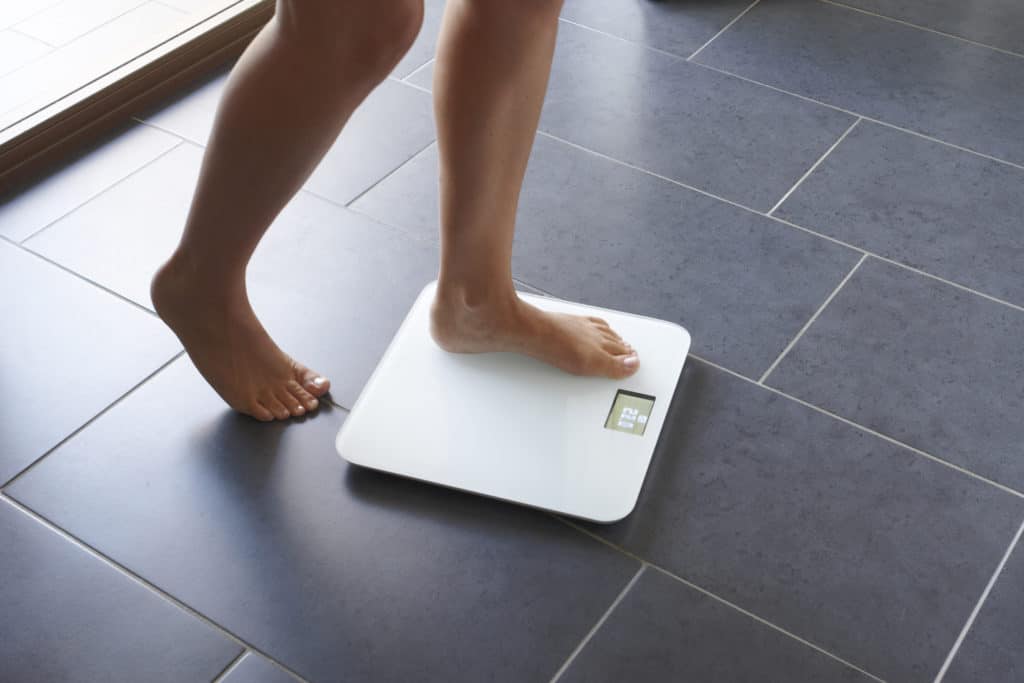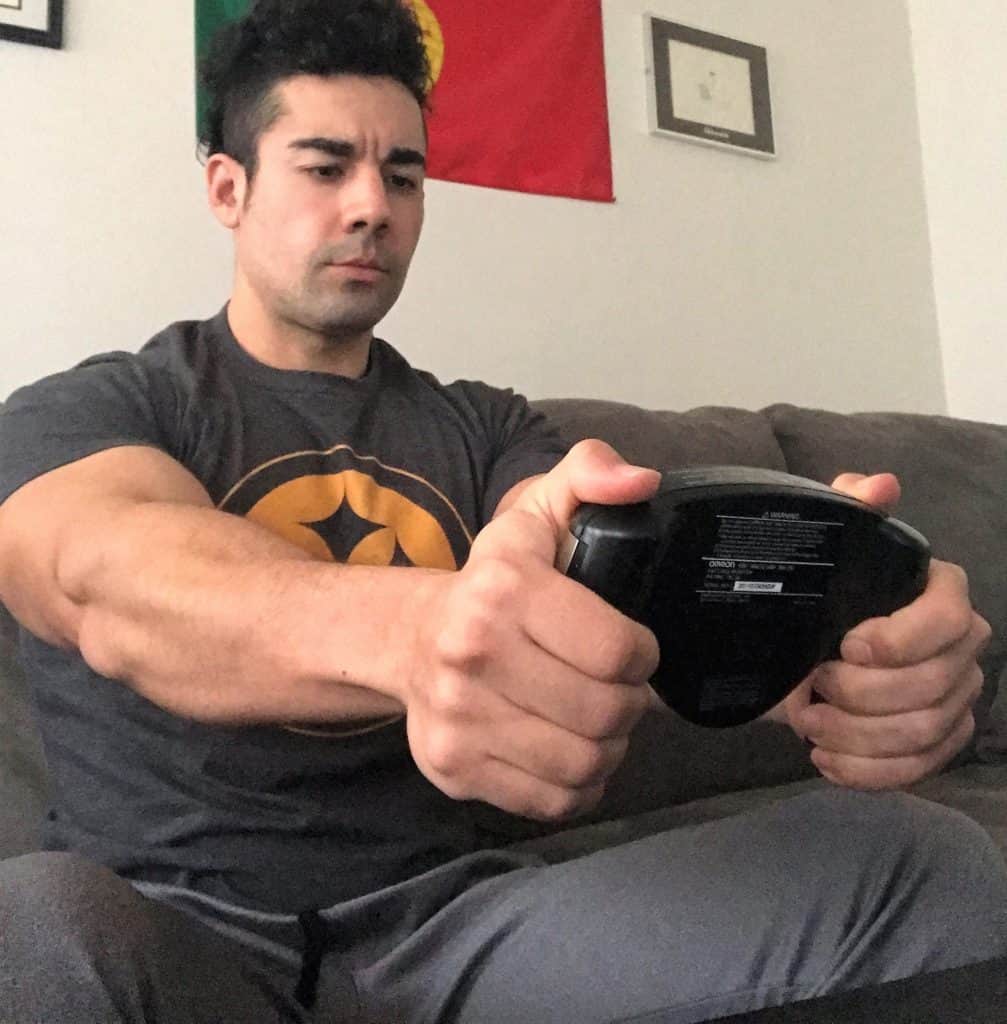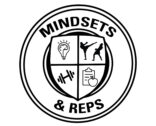
As a nutrition coach who’s worked with hundreds of clients, there is an obsession with the scale that is difficult to figure out. It’s as if one day a number is going to pop up that will magically boost self-esteem, confidence, and make all problems disappear. The scale is the most readily available measure of “health” we have, so perhaps that is the reason for the obsession. After all, who doesn’t have a bathroom scale somewhere in the house?
But the scale often lies. It has a weak correlation with body composition and muscle mass. I can show you a 160lb female who looks like a fitness model, and a 120lb woman with no muscle tone and a wide waist.
The picture below shows two UFC welterweight fighters, Kelvin Gastelum (left) and Tyron Woodley (right). They fought in the same weight class (Gastelum has since moved up to middleweight due to weight cutting issues) and likely walk around at around 190-195lbs when not competing.

The physiques aren’t even close however. Woodley clearly carries way more muscle mass while having sub 10 percent body fat. Gastelum, despite weighing about the same, has a softer physique with more body fat. This is one of many illustrations of how weight on a scale can yield two completely different results.
When someone changes their diet and training in an attempt to gain muscle, the number on the scale will increase. The question is whether the pounds are coming in the form of fat or muscle.
Below are a variety of different tools that measure changes in body composition in their own unique way.
Omron Hand Held Body Fat Scanner
Most gyms have a handheld scanner that the personal training department uses to track client progress. For as small and unassuming as it may look, it’s actually decently accurate. The key when using body fat measurement tools like this is to use the same tool over and over. If you go from a hand held scanner one week to body fat calipers to a DEXA scan you’re not going to get consistent measures. Pick one and use it every time.

The Omron Hand Monitor is the most convenient of the digital devices. It’s also a nice tool for nutritionists and trainers. You can get your own here.
InBody Body Fat Scanner
InBody scanners are less ubiquitous than the Omron hand scanners but they are popping up in more health clubs. Some places will even let you come in and pay about $30 to get a reading even if you are not a member. They give way more detailed results, down to body fat and muscle mass levels in specific areas of the body.

Again the accuracy is not perfect, even on a more sophisticated machine like this. Same rules apply, whatever body fat machine you choose stick with it for the duration of your bulk or cut. Also, try to take all measurements on an empty stomach. The best practice is first thing in the morning after using the bathroom. Even drinking water can have an effect on the results since water is a component of lean body mass.
Measurements
Body measuring tape is a great tool, particularly if you’re looking to add mass to a specific body part. There are even digital tapes that link to an app to track progress over time. But even if you do it the old fashioned way, tape measurements are a great representation of physique changes so long as you know how to use it properly.
The one possible exception would be waist measurements, which don’t take things like bloating into consideration. Still, measuring first thing in the morning can eliminate most of these variables.
Similar to measuring tape, monitoring how your clothes fit is an easy way to see how things are going. This method is typically used when tracking fat loss, but can be used for muscle gain as well. If the sleeves get tighter it’s usually good, but if you’re tugging at the belly to stretch it out it’s time to take another look at that diet.
Mirror and Photos
The mirror is the literal direct reflection of one’s appearance. It is the best measure of progress if used properly. What’s more, it’s easy and free. Everyone has a mirror in their house.
The only problem is that you look at yourself every day. Changes come slowly and subtly. This is why it’s important to take pictures. Weekly and monthly progress is far easier to identify than day-to-day. Set a mark on the floor and try to maintain the same lighting when taking pictures. Do it at the same time of day, preferably first thing in the morning. Food intake, water intake, and muscle pumps from workouts can skew the results.
There is a reason transformation photos are so powerful and inspiring; they’re the real deal (so long as they’re not photoshopped). The other tools listed are great, but can still be flawed in terms of accuracy and how they impact one’s physique on the surface. If the other tools show mixed results, but the photos show improvement and people are telling you how great you look, that’s a win!
When is the Scale Appropriate?
The one instance in which the scale provides some value is for very overweight or obese individuals looking to get down to a healthy weight. The scale is a good indicator of progress on their road to better health. This article is more about muscle gain, but the principles throughout apply to fat loss as well.
Body Mass Index (BMI), despite its flaws, is actually a decent barometer for what is considered a healthy weight. It’s biased against people with high levels of muscle mass, but 99% of the general population doesn’t resistance train.
I’ve changed my approach when working with severely overweight people. Initially we would do a great deal of resistance training, under the notion that the weight would naturally come off despite not doing a great deal of cardio.
With the strong correlation between obesity and other diseases, this strategy has changed. I now want to get them down to a healthy weight as soon as possible, and worry about muscle building later. This is not to say resistance training is completely neglected, because it isn’t. But there is now a greater focus on cardio and diet to drop weight more quickly.
From a muscle gaining perspective, the scale can be used in conjunction with other measures. Let’s use the example of an individual looking to put on muscle mass that weighs 180lbs and uses an Omron calculator that says he is 10% body fat.
180lbs x .10 = 18lbs of fat mass
As a result, they would be 162lbs of lean body mass
Let’s say they gain 5lbs, and the Omron calculator has a reading of 11.5% body fat.
185lbs x .115 = 21.275lbs of fat mass
As a result, they would be 163.725lbs of lean body mass
This means that of the 5lbs, a little over 3lbs was in the form of fat. Depending on the individual’s goals and expectations, they may not like these results and decide to tighten up their diet moving forward. But this example shows how using multiple measures can give a clearer indication of where the weight is coming from.
